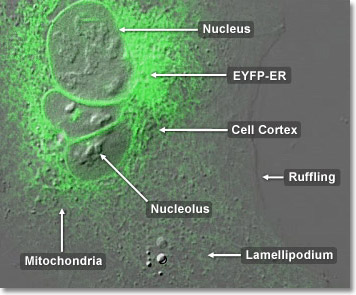Within the cell, the endoplasmic reticulum is suspended in the cytosol, one of the three major elements which makes up the cytoplasm, the others being organelles and inclusions. The cytosol is the semi-transparent fluid in which the other cytoplasmic elements are arranged. In addition to the endoplasmic reticulum, the cytoplasm holds and protects vacuoles, lysosomes and centrioles. Cytosol makes up about 70% of the cell and is composed of water, salts, and organic molecules. The cytoskeleton, various proteins, ribosomes and enzymes that are necessary for the cell to catalyze reactions are also found throughout the cytosol. Enzymes that take molecules and break them down so that individual organelles can use them as needed are part of the cytosol. In the digital video presented above, human osteosarcoma epithelial cells (U2OS line) are expressing a fusion of enhanced yellow fluorescent protein (EYFP) to an endoplasmic reticulum targeting signal.
As they start to navigate the biosynthetic-secretory pathway, proteins that have entered the endoplasmic reticulum (ER) on their way to the Golgi apparatus or beyond are first packaged into small COPII-coated transport vesicles. These transport vesicles are in regions of the ER called “exit sites” whose membrane doesn’t possess bound ribosomes. In most animal cells, ER exit sites seem to be haphazardly dispersed across the ER network. The grouping of proteins into vesicles that leave the ER can be a selective process. Several cargo proteins are actively recruited into such vesicles, where they become concentrated. It is believed these cargo proteins display exit (transport) signals on their surface that are recognized by complementary receptor proteins.

A lysosome is a specialized vesicle that holds a variety of enzymes. The enzyme proteins are first created in the rough endoplasmic reticulum (ER) and packaged in a vesicle before being sent to the Golgi apparatus which then does its final work to create the digestive enzymes and pinches off a small, very specific vesicle. That vesicle is a lysosome, and at this point the lysosomes float in the cytoplasm until they are needed. Lysosomes are primarily used for digestion, so they go to work when the cell absorbs or eats some food. Once the material is inside the cell, the lysosomes attach and release their enzymes. Lysosomes are sometimes nicknamed “suicide-bags” by cell biologists due to their role in autolysis, a process by which a biological cell self-destructs. This occurs when a lysosome allows the digestive enzymes out of its membranes, in effect, digesting itself.



